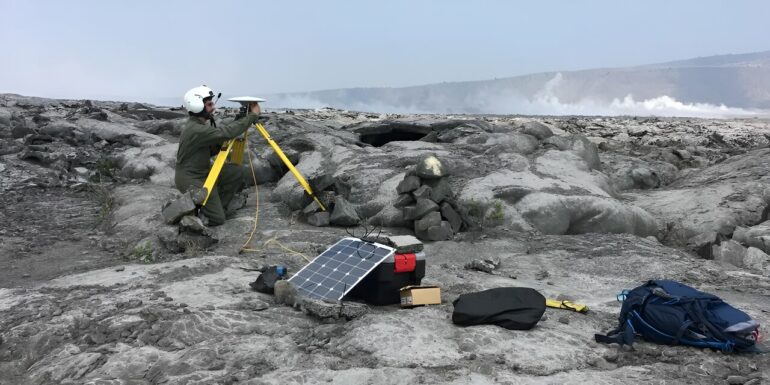Hawaii’s Kilauea volcano is one of the most active in the world. Its eruption in 2018 was its largest in 200 years and among the costliest volcanic disasters in U.S. history. Devastating as it was to the Hawaiian landscape, Kilauea’s eruption proved a boon to science. Researchers were there to collect unprecedented seismic and other data and say we might use it to understand the stresses that lead to major earthquakes.
“Kilauea is a model earthquake system,” said Paul Segall, the Cecil H. and Ida M. Green Professor in the Stanford Doerr School of Sustainability and lead author of the new study published in Nature Geoscience that harnesses this new data to better understand large earthquakes along tectonic fault lines, like the San Andreas and others.
“Kilauea gives us a unique chance to study many earthquakes over a short period of time, which is not available with tectonic earthquakes with recurrence intervals of hundreds to thousands of years.”
Each day or so in May through July of 2018, Kilauea’s caldera—a circular block of solid rock 5 miles round and half-a-mile thick weighing millions of tons—would collapse into a pool of molten rock below, sending off shockwaves.
Over many decades, scientists had developed extensive seismic and ground deformation monitoring networks on Kilauea. Leading up to the event and then as the eruption was starting, researchers supplemented these networks with sensors on and around the collapsing volcano summit, providing a never-before-available scale of observations. They used real-time Global Navigation Satellite System (GNSS) receivers, ground-based tilt meters, cameras, drones, and other sensors to trace the stage-by-stage collapse of the summit into the reservoir of molten magma below.
For the first time, they could estimate stresses acting on the volcanic system during caldera collapse and identify how these stresses caused a series of smaller shocks, which accelerated into larger, more frequent shocks, eventually culminating in major collapse earthquakes.
The team focused on the last 29 of 62 approximately day-long cycles of summit collapses Kilauea experienced in the summer of 2018. Each collapse proceeded through a series of numerous small shocks but always ended in earthquakes exceeding magnitude 5 on the Richter scale—quite considerable in seismic terms.
Each collapse cycle would begin as magma drained rapidly from below Kilauea’s summit to feed eruptions miles away. The magma chamber roof—that massive block of solid rock—would sag down into the molten reservoir, stressing the ring fault surrounding the caldera. Then, very quickly, it would fall—meters at a time—into the reservoir, pressurizing the underlying magma. Then the cycle would begin anew.
“We had GNSS instruments on the block of rock that was going down, and also on the outside of the ring fault. As the block dropped, so did those instruments and we could measure the changes,” said co-author Kyle Anderson, a geophysicist with the U.S. Geological Survey who was part of the team working onsite at Kilauea during the 2018 eruption.
“The subsidence repressurized the magma chamber and pushed the rest of the summit up and out,” Anderson noted of one of the surprises in the study. “People think of a caldera collapse as everything going down. And that’s true for the block itself. But not for the surrounding rock during these events.”
Recognizing patterns
The researchers also noticed another pattern. Prior to a collapse event, increasing stress on the overlying crust drove hundreds of small earthquakes, termed foreshocks. Eventually, large shocks propagated all the way around the 5-mile ring fault and the cap would collapse into the magma reservoir. Importantly, the researchers were able to use the rising and subsiding of the ground outside the caldera to estimate histories of changing stress inside the volcano.
“Over 29 cycles, we can look at this proxy for stress and compare it to the duration of the intervals between earthquakes,” said Segall, a professor of geophysics. “The faster this stress builds up, the more frequent earthquakes should be, and that’s what the data show.”
The researchers also found that the small foreshocks accelerated in frequency and intensity just before major earthquakes.
“As it got closer and closer to the main shock, we saw a higher propensity to have bigger events,” said Segall. “You get closer to a state where an earthquake can break through and grow to a larger size. In the last 10 to 15 minutes, the proportion of larger events grew much higher than in the previous 12 hours, as the system was getting closer to that point of rupture.”
Little stresses add up
This threshold phenomenon explains how small stress increases can lead to dramatic changes in the probability of earthquakes to increase in magnitude. Out of that insight, the Segall team proposed a model, based on previous theoretical studies, of how bumps and other rough places on the ring fault cause changes in localized stress levels that both initiate and impede earthquakes.
“We think this roughly circular fault is very irregular,” said Segall. “After a main shock, when the stress should be low on average, we start getting little earthquakes that rupture for some distance and then run into an unfavorable part of the fault. When the overall stress level gets higher, the chances of it popping through that and growing in size increases, and you can reach a point when an earthquake goes all the way around the fault and becomes a magnitude 5.3 or 5.4 earthquake.”
This research could be used to understand earthquakes in different environments, such as the San Andreas Fault or the Cascadia subduction zone. Segall’s team suggests that physical roughness of a fault controls the likelihood that an earthquake, once initiated, will grow into a potentially damaging shock. Researchers could attempt to calibrate this behavior using small shocks to determine the likelihood of a future damaging earthquake in different environments.
“Many of the same physical processes in volcanoes are operative on other faults,” Segall said. “While we’re not going to predict earthquakes based on our research anytime soon, we think the lessons learned and the overall knowledge about how the system operates should hold true. The question would be understanding the details enough that they could be applied in other settings.”
More information:
Paul Segall et al, Stress-driven recurrence and precursory moment-rate surge in caldera collapse earthquakes, Nature Geoscience (2024). DOI: 10.1038/s41561-023-01372-3
Provided by
Stanford University
Citation:
On Hawaii’s Kilauea, little stresses add up (2024, February 7)



